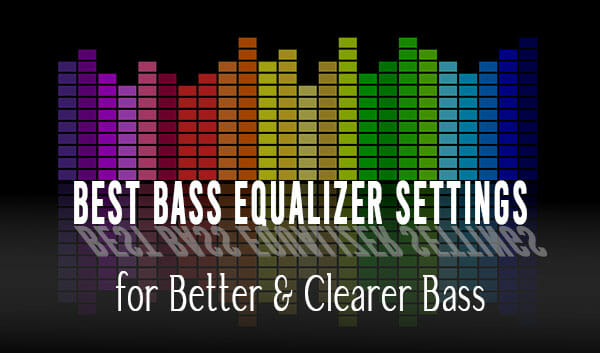
Who doesn’t love good music?
Everyone is bound to tap their feet or just hum along with the tune.
If you are someone who isn’t a fan of music then maybe you have figured it all wrong till now.
Don’t worry. We’ve got your back!
Trust us when we say this. We have some really amazing things for you that will jazz up your music world.
The only word to satisfy your queries is “Equalizer”.
Before going any bit further, let’s shake hands with Equalizer and understand what it really is.
It sounds too technical but we will try to break it down to you all and make it as easy as ABC.
Table of Contents
- What is EQ?
- Using EQ Settings For Better Bass In PC
- Using EQ Settings For Better Bass In Headphones
- Using EQ Settings For Better Bass In Car
What is EQ?
Equalizer or EQ is basically a sound processor that allows you to boost or cut certain frequency ranges. In simple and more normal terms, it enhances the sound quality.
Equalizer consists of frequencies ranging from 20Hz to 20KHz. That is also known as the audible range for a human ear. So this clearly means that only the sounds that fall in this range can make you feel a thump on your eardrum.
Why EQ?
All sounds are vibrations and the speed of this vibration is called frequency.
So, the sounds that vibrate at a slower frequency are lower in pitch and vice versa.
Wouldn’t it be interesting to have control over what you hear? We all like remote controllers, don’t we?
Hello, Equalizer!
Explanation of Different Settings in EQ
Okay, enough blabbering. Let’s understand the settings that will come handy and be useful for you.
You are ready to get equipped with this new weapon in your musical arsenal.
Before we take a step any further, you should be familiar with the different frequency ranges and what exactly they are used for.
Now that we know the two extreme frequencies that equalizers have (i.e. 20Hz-20kHz), we have a whole new range to play in between these two boundaries.
Every frequency that falls in this range is used to enhance the sound quality of the music to make it sound melodious.
All these frequencies are broadly divided into 6 main categories:
1. Sub-Bass
It usually consists of frequencies ranging from 20Hz to 60Hz. In order to hear that, you need a good music system or a good pair of headphones.
2. Bass
Moving on to bass, it consists of a frequency range between 60Hz to 200Hz.
So bass lovers, today you have finally found your frequency range.
3. Low Mids
This plays a significant role in mixing up music and ranges from 200Hz to 600Hz.
4. Mids
This is the range that human hearing mainly focuses on. That is, the range of
600Hz to 3KHz. So, getting it right here can do wonders.
5. Upper Mids
Things start to get a bit crispy in this 3KHz to 8KHz range. You all have heard about infamous EDM. Be careful with this range of frequency spectrum. If it can make you dance to your favourite song, it can also make your ears bleed (if you didn’t mix it up properly).
6. Highs
All the frequencies above 8KHz fall in this range. Here we get our treble as well as “air” frequencies. These frequencies are often more felt than heard like in case of sub-bass, but it makes quite an impact.
Bass And Treble
The music we hear is composed of many different frequencies merged together. Out of all the frequencies, the lower ones collectively form the bass for the musical harmony while the higher ones contribute to the treble. The treble, bass and volume (how could we forget this!) are adjusted to hit a sweet spot so that the music sounds even better (and finer). The adjustments, however, vary according to the audience and music.
The bass has proven to be a personal favourite of many. The charm in parties and long drives too. Bass has an ever-growing “FAN-BASS”.
So let’s learn to make the perfect adjustments for more enhanced and clearer bass!
Using EQ Settings For Better Bass In PC
What could be better than sitting at home and tuning to your favourite track?
If you don’t have a home theatre system in your home, don’t worry; your pc will get the job done with a few variations.
Windows includes a basic sound equalizer that can be adjusted.
- You need to reach out for the “Volume Control” icon in the tray in the bottom right corner. Right click and select “Playback Devices”.
- Open the speaker properties by right clicking on the speaker icon.
- Look through all the sections of “properties” that allows you to adjust the bass. It can be displayed under the name of “bass boost”, “bass balance” or “enhancement”.
- There you will see a bunch of options including “equalizer”. Click on “equalizer” and several options such as pop, jazz, classical, bass will be available.
- Click on “bass”.
And here you are, free to do all the magic with your fingertips.
On the horizontal axis, you will see the frequency ranges in hertz(Hz) and on the vertical axis, there is sound in decibel(dB). Divided into two sections by 0dB. Above 0db is +6db and +12db and below it is -6db and -12db.
Set your sub-bass to +6db, your bass to slightly below +6db. Set low mids to 0db and set your mids to the range exactly as your bass. And your upper mids and highs slightly below mids.
Now put on your dancing shoes and enjoy!
Using EQ Settings For Better Bass In Headphones
We are all guilty of travelling with headphones on and shutting the world down, who doesn’t love that! But to add to this wonderful experience; you need to adjust the bass settings in your headphones.
Simply open the equalizer settings on your phone and
- Set sub-bass slightly above +6db.
- Bass to exactly in between 0db and +6db
- Set low-mids at slightly below 0db.
- Set mids and upper mids exactly where the bass adjusted to.
- Finally, your highs must be adjusted slightly lower than upper mids.
Isn’t that amazing? You have your favourite song and that too with your favourite choice of bass settings.
I bet your travel is going to be a lot more enjoyable from now on.
Using EQ Settings For Better Bass In Car
Before we dig into the settings, it would be wise to get a little gist of the features.
Balance and Fade Control
They control the amount of sound from each speaker. Balance controls the speakers from left to right while fader makes it possible to take control from front to rear.
Loudness
Yes! It is important. The loudness influences the sweet spot to a much greater extent. Melodious music played too loudly turns discordant.
Subwoofer Level (SW Level)
The RCA output can be utilized as a Subwoofer output that enhances the bass and jazzes up the mood.
Care should be taken to make sure that the RCA output is being utilized as the subwoofer output while the rear speaker functions as full-range.
When you switch the Subwoofer level “on”, you get access to adjust the subwoofer output. You can now change the settings to make the subwoofer output according to your ease and comfort.
Dynamic Bass Control
Many cars have the “dynamic” bass mode enabled. This mode takes care of producing high-quality, emphasizing bass in cars.
Now that we know much about our tools, it’s time to be a better craftsman.
Adjust the sound from the front and rear speakers. The front speakers may provide a much lyrical or treble sound, but the rear ones fill depth to the sound from the front speakers.
Adjust the sub-woofer level by lowering the high-pass filter of the front speakers to the least frequency that they can handle. Now, steadily increase the frequency until you hear the bass notes clearly.
Frequently Asked Questions About Bass Equalizer Settings
What does an equalizer do for car audio?
It lets you tune to your car’s audio by giving a few adjustments in the frequency range.
Should you use an equalizer?
It is entirely up to you. But using equalizer enhances your audio and you enjoy music even more.
What Hz is best for bass?
The best setting for bass is between the frequency range of 60Hz to 250Hz.
Is Bass high or low frequency?
Bass is a low range of frequencies. All the deep sounding voices come in this range. Treble deals with high frequency sounds.
Conclusion
There you go. That’s the breakdown of EQ settings that is better for clearer bass. There aren’t any specific adjustments that prove to be perfect for everyone.
These settings might be a bit different in your device or car. But a few adjustments here and there will let you enjoy the perfect bass.
We tried to bring these settings as close to perfection so that you all could enjoy your music even more.
Once you learn how EQ works, start mixing your music and you will discover more things that will make you fall in love with music at a whole new level.

